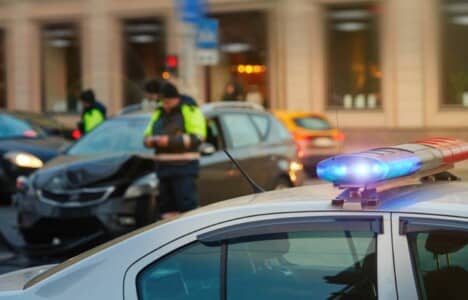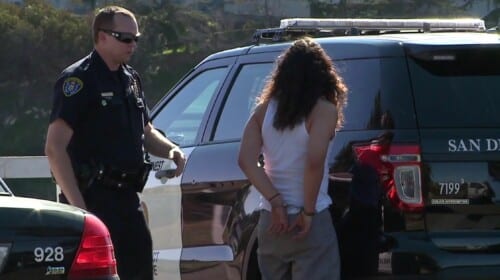
Hit and run cases can be hard to prosecute because there isn’t always physical evidence or a witness who saw what happened. For prosecutors to get a conviction, they must have enough proof to show beyond a reasonable doubt that the accused person caused an accident or injury. This article will examine what types of evidence are necessary in order to prove guilt in these cases, such as video footage, eyewitness accounts, physical damage, or chemical tests.
Table of Contents
What Is A Hit And Run Accident?
A hit and run accident is an incident where a driver causes harm to another person, animal, object, or vehicle and then flees the scene of the accident without providing any contact information, such as name and address. This form of a car accident can result in physical damage to property or persons, injuries, or even death. In order for the legal system to prosecute someone for committing this type of crime, there needs to be evidence that suggests that they were at fault for causing it. The most common forms of evidence used in hit and run cases include video footage, eyewitness accounts, physical damage from the crash itself, and chemical tests taken from the scene.
Evidence Needed To Prove Hit And Run Charges
The evidence required to prove hit and run charges is unique to each case and will depend on what has occurred. Generally, some of the most common types of evidence used to prove a hit and run include:
- Surveillance cameras or dash cams may capture video footage of the incident, and investigators can use this footage as evidence to prove that the accused caused the auto accident. Such footage is often critical in establishing the accused’s guilt.
- Eyewitness Accounts: Witnesses who can testify to what they saw at the time of the incident can be extremely helpful in providing an account of what happened.
- Physical Damage From The Crash: Police officers and other investigators will look for damage to vehicles, property, or persons to figure out what occurred at the scene.
- Chemical Tests: Investigators may conduct chemical tests, such as analyzing the soil or measuring skid marks at the hit and run location. These tests can provide valuable evidence to help determine what happened during the incident.
In order to convict someone of hit and run, prosecutors must be able to demonstrate beyond a reasonable doubt that the accused was at fault for causing an accident or bodily injury. The evidence presented must be strong enough to show that the accused had knowledge of what they were doing and were responsible for the incident. Prosecutors can secure a conviction even if the accused was not present at the accident scene or fled before the police arrived by presenting the right evidence. To do so, prosecutors must establish the following key elements:
- That an accident occurred.
- That the defendant was behind the wheel of the car related to the crash.
- That the defendant was aware or should have been aware of an accident taking place.
- That the defendant neglected to remain at the site of the accident.
- That the victim suffered damages as a result of the accident.
Misdemeanor vs. Felony Hit And Run Charges
In the United States, hit and run refers to the act of a driver involved in a traffic collision who fails to stop at the scene and provide required information to the other driver or law enforcement. Hit and run is a criminal offense and can be charged as either a misdemeanor or a felony, depending on the severity of the incident and the hit and run laws of the state in which it occurred.
A misdemeanor hit and run is typically less serious than a felony hit and run and is usually punishable by a fine and/or a short county jail sentence. Authorities may file misdemeanor hit and run charges when the incident involves only minor injuries or property damage.
A felony hit and run, on the other hand, is a more serious crime that is punishable by a longer jail sentence and/or a more significant fine. Authorities may file felony hit and run charges when the incident involves significant property damage, serious injuries, or fatalities.
In general, the main difference between a misdemeanor and felony hit and run charge is the severity of the crime and the potential consequences of a conviction. Misdemeanor hit and run charges are typically less serious and carry less severe penalties, while felony hit and run charges are more serious and carry more severe penalties. If authorities charge you with a hit and run, it is crucial to consult a qualified defense lawyer since the laws and penalties for hit and run vary by state.
Possible Penalties For A Hit And Run
It is critical to be aware that serious, long-term consequences may result from a hit and run, both criminally and civilly. Criminal penalties can include anything from a fine and/or jail time to the suspension of the offender’s driver’s license. Civil penalties, on the other hand, can include anything from the payment of medical bills to restitution for property damage. The court may impose a “victim surcharge” on the offender to compensate the victims for their losses. The court sets this additional fee. We’ve broken it down further for you below:
— Criminal Hit And Run Charges
In general, criminal penalties for hit and run charges can include the following:
- Fines: The court may order individuals convicted of hit and run to pay a fine as part of their sentence. The amount of the fine will depend on the specific laws of the state in which the hit and run occurred, as well as the severity of the incident.
- Jail or prison time: The court may sentence an individual to serve time in jail or prison depending on the circumstances of the hit and run as part of their sentence. The length of the jail or prison sentence will depend on the severity of the hit and run and the laws of the state in which it occurred.
- Probation: The court may sentence individuals convicted of hit and run to probation as part of their sentence. Probation typically includes requirements such as regularly reporting to a probation officer, attending counseling, or participating in community service.
- Driver’s license points: Individuals convicted of hit and run may also have points added to their driver’s license as part of their sentence. The severity of the offense and the laws in the state in which it occurred will determine the number of points added.
- Community service: The court may require some individuals convicted of hit and run to perform community service as part of their sentence. This may include activities such as cleaning up litter, volunteering at a nonprofit organization, or working on community projects.
- License suspension or revocation: In many states, a hit and run conviction can result in the suspension or revocation of a driver’s license. The length of the suspension or revocation will depend on the specific laws of the state in which the hit and run occurred, as well as the circumstances of the incident.
— Civil Hit And Run Charges
In addition to facing criminal penalties, individuals charged with a hit and run may also face civil penalties. Civil penalties for hit and run may include:
- Civil lawsuits: The victim or the victim’s family may file a civil lawsuit against the individual charged with hit and run, seeking damages for injuries, property damage, or other losses resulting from the hit and run. If the court finds the individual liable in a civil lawsuit, the individual may have to pay damages to the victim or the victim’s family.
- Increased insurance premiums: A hit and run conviction may result in higher insurance premiums for the individual charged with the offense. Insurance companies may view hit and run as a high-risk behavior and may charge higher premiums as a result.
- Difficulty obtaining insurance: Insurance companies may refuse to provide coverage to individuals convicted of hit and run, or they may charge significantly higher premiums. This can make it more difficult for individuals with a hit and run conviction to obtain insurance coverage.
- Payment of medical bills: If the court finds the individual charged with hit and run guilty, they may have to pay any medical bills incurred by the victim as a result of the hit and run. These medical bills may include expenses such as ambulance fees, hospital stays, and medical procedures. The court may order the individual to pay medical bills as part of a criminal sentence, or the victim or the victim’s family may require the individual to pay the bills as part of a civil lawsuit.
- Payment for property damage: It is possible for a victim or their family to recoup monetary compensation through either criminal sentencing or civil litigation should property damage occur. The court may order the individual charged to pay such payment as part of the sentence, giving those affected by the crime a sense of justice and resolution. The individual may also be responsible for all costs related to repairing or replacing any public property damaged in the hit and run incident, such as a traffic sign or guardrail.
Will Insurance Cover Hit And Run Damages?
The specific terms and conditions of an auto insurance policy will determine whether it covers hit and run damages. Most auto insurance policies generally include coverage for damages caused by an uninsured driver or a driver who cannot be identified (a hit and run). Typically referred to as uninsured/underinsured motorist coverage or hit and run coverage, auto insurance policyholders can request these optional coverages, and they are not required by law. If the policyholder has this type of coverage and their motor vehicle is damaged in a hit and run, they can file a claim with their insurance company to pay for the damages.
It’s important to note that auto insurance policies vary, and hit and run damages may not be covered in all policies. Policyholders should carefully review their policy and discuss their coverage options with their insurance provider if they are concerned about being covered for hit and run damages.
What To Do After A Car Accident
If you are involved in a car accident, it is important to take the following steps to ensure your safety and protect your legal rights:
- Check for injuries: If anyone is injured in the vehicle accident, call 911 or your local emergency number immediately to get medical treatment. If you are able to do so, provide first aid to anyone who is injured until emergency medical personnel arrive.
- Call the police: If there are injuries, significant property damage, or a hit and run involved in the accident, it is important to call the police. The police will investigate the accident and prepare an official police report, which may be useful in resolving any insurance claims or legal issues that may arise. If you were able to capture a license plate number, it would go a long way in helping police track down the hit and run driver.
- Exchange information: If you are involved in an accident with another driver, exchange insurance and contact information with that driver. Make sure to get the other driver’s name, address, phone number, and insurance information. If there are witnesses to the accident, make a note of their names and contact information as well.
- Take photos: If it is safe to do so, take photos of the accident scene, including the damage to the vehicles and any visible injuries.
- Move your vehicle: If your vehicle is blocking traffic or is in a dangerous location, and it is safe to do so, move it to a safer location. If you are unable to move your vehicle, turn on your hazard lights to alert other drivers.
- Contact your insurance company: After the accident, it is important to contact your insurance company to report the accident and begin the claims process. Be sure to have your policy number and other relevant information handy.
- Seek legal advice: If you were injured in the accident or if there was significant property damage or other legal issues involved, it is advisable to seek legal advice from a qualified criminal defense attorney. An attorney can offer a free consultation to help you understand your rights and options and can assist you in resolving any legal issues that may arise.
The Bottom Line
Hit and run cases can be difficult to prove, but with the right evidence, prosecutors may be able to demonstrate beyond a reasonable doubt that the accused was at fault for causing an accident or injury. In order to secure a conviction, it is essential that law enforcement collect as much evidence from the scene of the crime as possible, including video footage, eyewitness accounts, physical damage, or chemical tests. It’s also important for victims of hit and run accidents to contact their insurance companies in order to determine what type of coverage they have, if any, against these types of hit and run situations. Lastly, seeking legal advice from an attorney may help you understand your rights and options when dealing with hit and run incidents.
Frequently Asked Questions (FAQ’s)
Is a hit and run a felony?
Yes, a hit and run typically is considered a felony. Depending on the country or state, it can range from a misdemeanor to a felony offense. In some cases, leaving the scene of an accident can carry jail time or hefty fines. The exact consequences depend on the specifics of what happened in the incident. In most cases, though, fleeing after causing injury or property damage is usually classified as a felony offense. It is best to consult an attorney to understand what criminal charges you may be facing in a hit and run case.
What is the difference between a hit and run and leaving the scene of an accident?
The difference between a hit and run and leaving the scene of an accident is that a hit and run involves purposefully fleeing the scene of an incident after causing property damage or injury to another person. Leaving the scene without exchanging insurance information or offering assistance may be considered a crime, depending on what occurred during the incident. Fleeing from the scene with the intent to evade responsibility for damages or harm caused is what distinguishes it from simply leaving an accident without providing necessary information or assistance.
Do the penalties change if someone is injured in a hit and run?
Yes, the penalties for a hit and run may be more severe if someone is injured. Depending on the county or state law, leaving the scene of an accident can carry jail time or hefty fines if someone is injured. In some cases, a hit and run with an injury could even result in felony charges, which could result in harsher penalties than what would otherwise have been imposed without an injury being involved. It’s important to consult with an attorney to understand what charges you may face in a hit and run case with injuries involved.
What is the penalty for hit and run if the driver is intoxicated?
If a driver is intoxicated at the time of the incident, the penalty for hit and run may be more severe. In general, hit and run is a criminal offense that law enforcement officials can charge as either a misdemeanor or a felony, depending on the severity of the incident and the laws of the state in which it occurred. If the driver was intoxicated at the time of the hit and run, they may face additional charges for driving under the influence (DUI) or driving while intoxicated (DWI).
In addition to facing criminal penalties for hit and run and DUI/DWI, the driver may also face civil penalties, such as a civil lawsuit from the victim or the victim’s family seeking damages for injuries, property damage, or other losses resulting from the hit and run.


